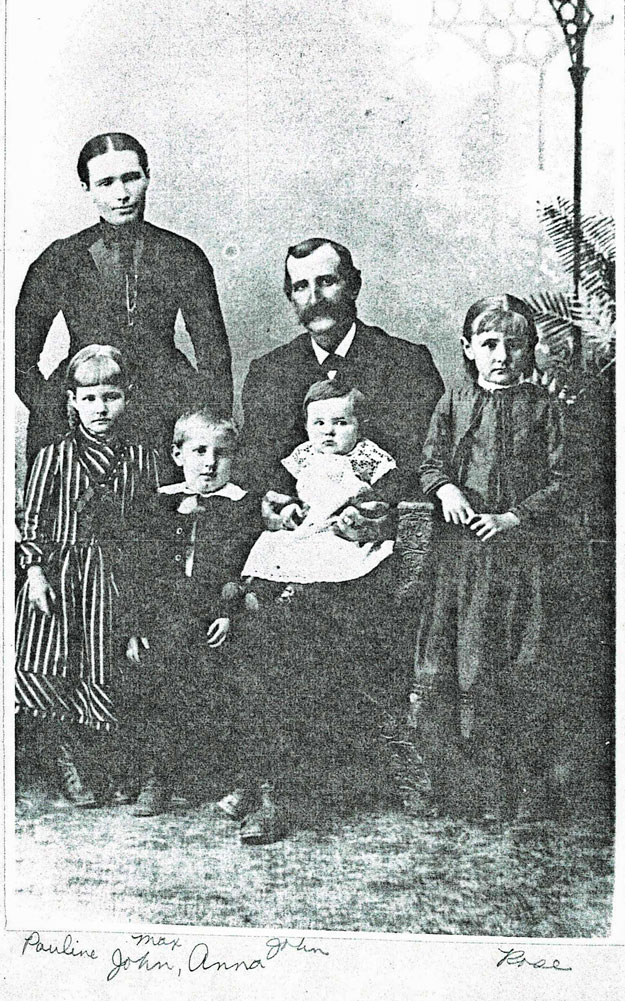The bartered bride and the Lone Tree Schweiger Ranch
By Joe Gschwendtner; photo courtesy of Rose Tuggle Collection of the Schweiger Ranch Foundation

Picture taken circa 1891. Anna is in upper left, husband John in the middle, and Rose the oldest child, age 6 on the right.
John Schweiger was raised in Zell am Ziller, Tirol, Austria. Draftable into the Austrian army, he found a berth on an American-bound ship out of Bremen days before he turned 21 in 1867.
Stateside, John found work in Tennessee and Georgia’s mining industry. When brothers Jacob and Joseph arrived from Tirol, they all relocated to Leadville to work for Horace Tabor’s sampling mills; he was the husband of “Baby Doe.” Later, they moved to Denver, arranging for their parents to emigrate from Austria.
Craving country life again, the brothers rented three livery horses and rode 30 miles south. According to daughter Rose Tuggle, John said, “Stop right here. This is it. This is what I want.” He purchased the first 80 acres from the Kansas Pacific Railroad for $410. All brothers and their father filed their own homestead claims on adjacent properties.
After the Schweigers’ parents died, the brothers desperately needed domestic help. Rather clinically, by drawing straws, John the loser, was “selected” to marry. Soon after, John encountered George Engl of Lake Gulch who had two nieces visiting with him. John, now on a mission, was invited for dinner the following Sunday. He was anxious to meet the oldest girl.
Anna Scheider was shy. So much so, she wouldn’t meet John until called out of the kitchen by her aunt. More visits followed with the same result. Finally, with Engl’s help, John cornered Anna in the parlor one evening. With little fanfare, he proposed marriage. She said she accepted, but only because the Engls insisted. They were wed on January 1, 1885. Over the course of their life together, Anna would give birth to seven children.
Prior to the marriage, the brothers built a new ranch house. Nearing completion, a fellow rode up, dismounted, advising he was ready to move into the house, as it had been built on his land. Presenting irrefutable proof of ownership, he confirmed their mistake. The good news, while dead serious, the owner offered to sell the ground needed and another 80 acres. The brothers then planted a lone tree in the front yard.
One evening over beer and pretzels, a guest claimed to love the ranch but didn’t know its name. No one had thought much about it until then. They recalled a round-up years ago. Among cowhands staying in Schweiger Ranch cabins was a drifter named Jack Johnson. Each morning, he would ride on his magnificent horse to some special spot in the hills, stop and then sing. John remarked, “He brought music to the hills with his magnetic voice, rich and true.” Folks began calling him “Happy Jack,” and he was admired by all. On the spot, Joseph declared their homestead “Happy Canyon Ranch.”
John managed the ranch like his family, with an iron-willed, dictatorial German efficiency. Though frail and suffering from debilitating migraines, Anna remained committed to their partnership. Oldest daughter Rose became her emotional confidante. While John is credited as the engine of success, Anna’s unfailing devotion and the labors of their seven children must be equally weighed. By 1925, the Happy Canyon Ranch had grown to a monumental 3,500 acres.
Today, the Happy Canyon (Schweiger) Ranch is located just south of the RidgeGate Parkway Station for RTD’s light rail. Managed by the Schweiger Ranch Foundation in Lone Tree, it is periodically open for ranch and self-guided tours. For more information, visit, https://schweigerranch.org.